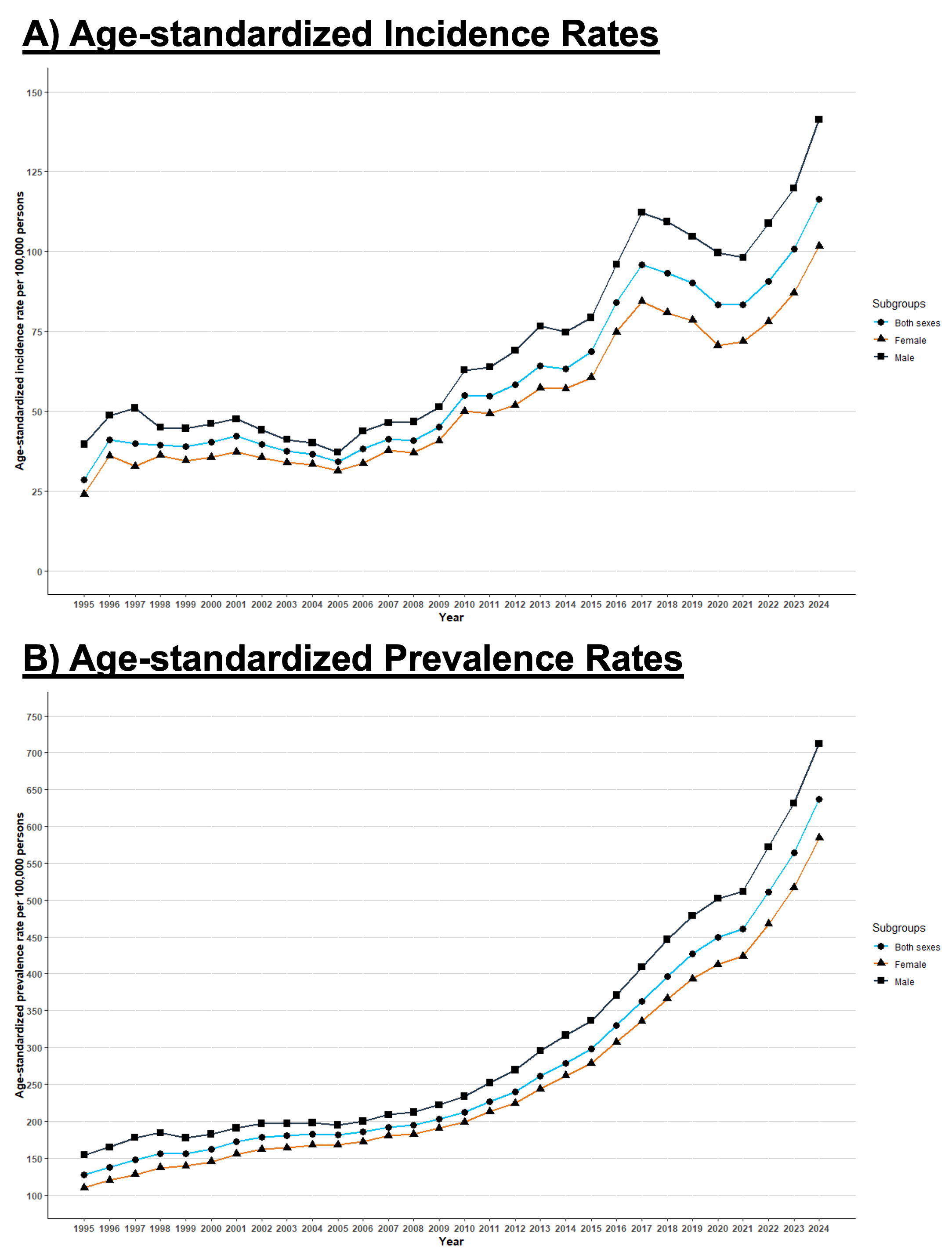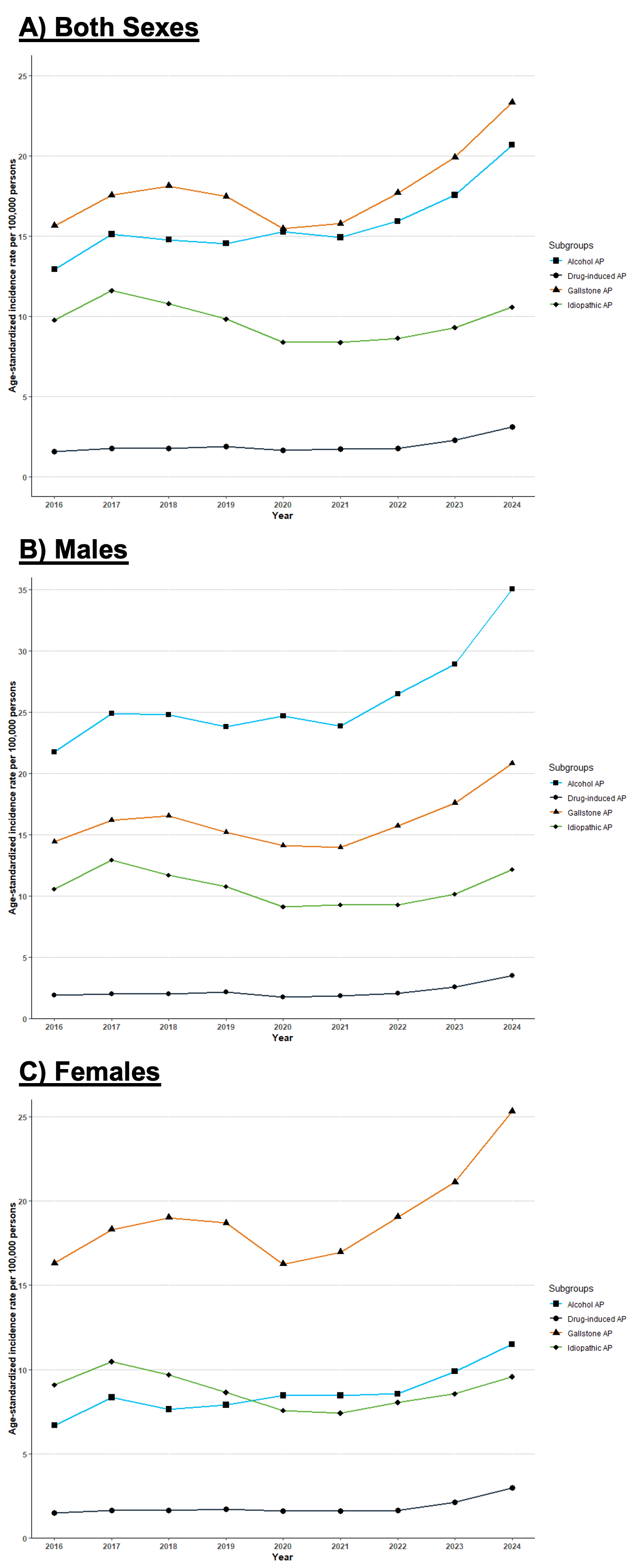Sunday Poster Session
Category: Biliary/Pancreas
P0007 - Sex-Based Differences in the 20-Year Epidemiologic Shift of Acute Pancreatitis in the United States: A Nationwide Population-Based Analysis (1995-2024)
Sunday, October 26, 2025
3:30 PM - 7:00 PM PDT
Location: Exhibit Hall

Daniel M. Simadibrata, MD
Case Western Reserve University / MetroHealth
Cleveland, OH
Presenting Author(s)
Daniel M. Simadibrata, MD1, Zaid Al-Fakhouri, MD1, Laith Alomari, MD2, Noppachai Siranart, MD3, Richard CK Wong, MD1
1Case Western Reserve University / MetroHealth, Cleveland, OH; 2Thomas Jefferson University, Philadelphia, PA; 3Brigham and Women's Hospital, Boston, MA
Introduction: Despite gallstones and alcohol being the two common etiologies of acute pancreatitis (AP), recent data suggests declining trends in gallstone AP while alcoholic AP remains stable. However, nationwide data in the United States on evolving AP epidemiology and sex-based differences in etiology remain limited. This study aimed to analyze temporal trends in the incidence and prevalence of AP in the United States over 20 years.
Methods: A population-based analysis was performed using data from TriNetX, an aggregated real-world healthcare database. Incident cases of AP from 1995 to 2024 were identified using ICD-9 and ICD-10 codes, restricted to the first recorded episode. Age-standardized incidence rates (ASIR) and prevalence rates (ASPR) per 100,000 persons were calculated. Stratified analyses by sex and etiology (ICD-10 data limited to 2016-2024) were performed. Temporal trends were assessed using Joinpoint regression, with annual percentage changes (APCs) and 95% confidence intervals (95%CI).
Results: From 1995 to 2024, 558,264 incident AP cases were identified. Overall, the ASIR and ASPR of AP showed consistent upward trends, with APCs of 4.33% (95%CI 3.66% to 5.00%) and 5.19% (95%CI 4.68% to 5.70%), respectively. Joinpoint regression revealed distinct phases in AP incidence: sharp increase from 1995 to 1997 (APC 18.45%; 95%CI 7.00% to 26.87%), decline through 2005 (APC -2.41%; 95%CI -5.66% to -0.85%), followed by steady increase until 2018 (APC 7.82%; 95%CI 6.72% to 9.24%). Rates plateaued from 2018 to 2021 (APC -4.39%; 95%CI -7.66% to +6.09%), then increased again through 2024 (APC 12.11%; 95%CI 4.41% to 22.64%).
Sex-stratified analyses demonstrated significantly higher ASIR and ASPR in males compared to females, despite parallel upward trends in both groups. Gallstone and alcoholic AP remained the most common etiologies. While all etiologies showed rising ASPRs, only alcoholic and drug-induced AP had significantly increased ASIRs (APC 4.27%; 95%CI 1.32% to 7.35% and 5.76%; 95%CI 1.65 to 10.14%, respectively). Gallstone AP was more prevalent in females, while alcoholic AP was more prevalent in males. In females, the incidence of alcohol-related AP surpassed idiopathic AP in 2020, becoming the second most common etiology.
Discussion: This large-scale, population-based study highlights a rising burden of AP in the United States over the past two decades. Alcoholic AP remains predominantly a male disease but is increasing among females, while gallstone AP continues to dominate among females.

Figure: Figure 1. A) Age-standardized Incidence Rates and B) Age-standardized Prevalence Rates of Acute Pancreatitis in the United States (1995 to 2024)

Figure: Figure 2. Trends in Acute Pancreatitis by Etiology A) in Both Sexes, B) in Males, C) in Females
Disclosures:
Daniel Simadibrata indicated no relevant financial relationships.
Zaid Al-Fakhouri indicated no relevant financial relationships.
Laith Alomari indicated no relevant financial relationships.
Noppachai Siranart indicated no relevant financial relationships.
Richard CK Wong indicated no relevant financial relationships.
Daniel M. Simadibrata, MD1, Zaid Al-Fakhouri, MD1, Laith Alomari, MD2, Noppachai Siranart, MD3, Richard CK Wong, MD1. P0007 - Sex-Based Differences in the 20-Year Epidemiologic Shift of Acute Pancreatitis in the United States: A Nationwide Population-Based Analysis (1995-2024), ACG 2025 Annual Scientific Meeting Abstracts. Phoenix, AZ: American College of Gastroenterology.
1Case Western Reserve University / MetroHealth, Cleveland, OH; 2Thomas Jefferson University, Philadelphia, PA; 3Brigham and Women's Hospital, Boston, MA
Introduction: Despite gallstones and alcohol being the two common etiologies of acute pancreatitis (AP), recent data suggests declining trends in gallstone AP while alcoholic AP remains stable. However, nationwide data in the United States on evolving AP epidemiology and sex-based differences in etiology remain limited. This study aimed to analyze temporal trends in the incidence and prevalence of AP in the United States over 20 years.
Methods: A population-based analysis was performed using data from TriNetX, an aggregated real-world healthcare database. Incident cases of AP from 1995 to 2024 were identified using ICD-9 and ICD-10 codes, restricted to the first recorded episode. Age-standardized incidence rates (ASIR) and prevalence rates (ASPR) per 100,000 persons were calculated. Stratified analyses by sex and etiology (ICD-10 data limited to 2016-2024) were performed. Temporal trends were assessed using Joinpoint regression, with annual percentage changes (APCs) and 95% confidence intervals (95%CI).
Results: From 1995 to 2024, 558,264 incident AP cases were identified. Overall, the ASIR and ASPR of AP showed consistent upward trends, with APCs of 4.33% (95%CI 3.66% to 5.00%) and 5.19% (95%CI 4.68% to 5.70%), respectively. Joinpoint regression revealed distinct phases in AP incidence: sharp increase from 1995 to 1997 (APC 18.45%; 95%CI 7.00% to 26.87%), decline through 2005 (APC -2.41%; 95%CI -5.66% to -0.85%), followed by steady increase until 2018 (APC 7.82%; 95%CI 6.72% to 9.24%). Rates plateaued from 2018 to 2021 (APC -4.39%; 95%CI -7.66% to +6.09%), then increased again through 2024 (APC 12.11%; 95%CI 4.41% to 22.64%).
Sex-stratified analyses demonstrated significantly higher ASIR and ASPR in males compared to females, despite parallel upward trends in both groups. Gallstone and alcoholic AP remained the most common etiologies. While all etiologies showed rising ASPRs, only alcoholic and drug-induced AP had significantly increased ASIRs (APC 4.27%; 95%CI 1.32% to 7.35% and 5.76%; 95%CI 1.65 to 10.14%, respectively). Gallstone AP was more prevalent in females, while alcoholic AP was more prevalent in males. In females, the incidence of alcohol-related AP surpassed idiopathic AP in 2020, becoming the second most common etiology.
Discussion: This large-scale, population-based study highlights a rising burden of AP in the United States over the past two decades. Alcoholic AP remains predominantly a male disease but is increasing among females, while gallstone AP continues to dominate among females.

Figure: Figure 1. A) Age-standardized Incidence Rates and B) Age-standardized Prevalence Rates of Acute Pancreatitis in the United States (1995 to 2024)

Figure: Figure 2. Trends in Acute Pancreatitis by Etiology A) in Both Sexes, B) in Males, C) in Females
Disclosures:
Daniel Simadibrata indicated no relevant financial relationships.
Zaid Al-Fakhouri indicated no relevant financial relationships.
Laith Alomari indicated no relevant financial relationships.
Noppachai Siranart indicated no relevant financial relationships.
Richard CK Wong indicated no relevant financial relationships.
Daniel M. Simadibrata, MD1, Zaid Al-Fakhouri, MD1, Laith Alomari, MD2, Noppachai Siranart, MD3, Richard CK Wong, MD1. P0007 - Sex-Based Differences in the 20-Year Epidemiologic Shift of Acute Pancreatitis in the United States: A Nationwide Population-Based Analysis (1995-2024), ACG 2025 Annual Scientific Meeting Abstracts. Phoenix, AZ: American College of Gastroenterology.
